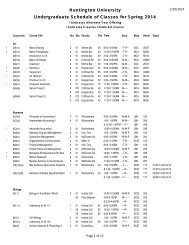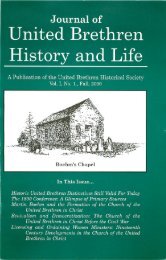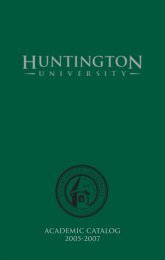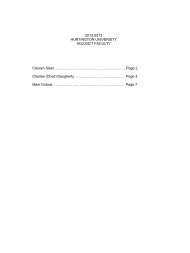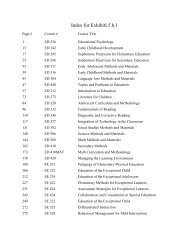Gillian Clark, Christianity and Roman Society - Huntington University
Gillian Clark, Christianity and Roman Society - Huntington University
Gillian Clark, Christianity and Roman Society - Huntington University
You also want an ePaper? Increase the reach of your titles
YUMPU automatically turns print PDFs into web optimized ePapers that Google loves.
BOOK REVIEWS 105<br />
Some minor quibbles: A thin volume obviously must be highly selective, but a<br />
sketch of the Christian influence upon <strong>Roman</strong> economics <strong>and</strong> <strong>Roman</strong> family life would<br />
have been valuable. <strong>Clark</strong> masterfully communicates the literary evidence, but a few<br />
epigraphical, papyrological, or numismatic sources would have elucidated the<br />
discussions. <strong>Clark</strong>’s reference to an “episcopalian” polity in the Pauline epistles is<br />
misleading (28). <strong>Clark</strong> maintains that “language barriers” between “Latin- <strong>and</strong> Greekspeaking<br />
churches” exacerbated the “long-lasting divisions” after Chalcedon, <strong>and</strong> she<br />
also refers to the modern reevaluation of “monophysitism” (34). But recent scholarship<br />
has reevaluated so-called “Nestorianiasm” as well; <strong>and</strong> inter-Greek confusion<br />
(concerning terms such as prosopon <strong>and</strong> phusis) <strong>and</strong> Syriac <strong>and</strong> Coptic barriers<br />
complicated the post-Chalcedonian divisions. <strong>Clark</strong> also mentions, without further<br />
comment, H. A. Drake’s simplistic assessment that “the martyr <strong>and</strong> the apologist” are<br />
“representative of an internal tension in <strong>Christianity</strong>, ‘the martyr st<strong>and</strong>ing for rigor <strong>and</strong><br />
exclusion, the apologist for cooperation <strong>and</strong> inclusion’” (48). <strong>Clark</strong> maintains that<br />
“[there] is very little evidence for what happened” in the Decian persecution “with one<br />
exception,” that of Cyprian’s Carthage (49). However, other evidences come to mind,<br />
such as the treatment of Dionysius of Alex<strong>and</strong>ria <strong>and</strong> Origen. She states that Augustine<br />
preferred the representation of the church as a net, since the Donatists employed the<br />
image of the ark (97). But compare City of God XV.26-27. Both the ark <strong>and</strong> the church<br />
house represent the “clean <strong>and</strong> the unclean,” until the “appointed end.”<br />
<strong>Clark</strong> has attempted to make contemporary academic scholarship available to a<br />
broad audience <strong>and</strong> especially students. Her opening pages appropriately quote Phocas:<br />
“Long books scare students. This is one for them, <strong>and</strong> anyone who likes some serious<br />
thoughts concisely said” (vii). <strong>Clark</strong> fittingly explains important Greek <strong>and</strong> Latin terms<br />
within the text <strong>and</strong> without breaking the flow of thought. On the other h<strong>and</strong>, the book is<br />
inconsistent in its references to primary sources, confusingly so for non-classicist<br />
undergraduates. The Bibliographical Essay at the end of the book overlooks pertinent<br />
volumes in the Loeb Classical Library <strong>and</strong> the Penguin Classics Series. The essay further<br />
discusses a certain “Hall (1991),” but this citation cannot be tied to any work in the<br />
reference list. Nevertheless, the Bibliographical Essay <strong>and</strong> the reference list will be useful<br />
resources for undergraduate <strong>and</strong> graduate research. All in all, <strong>Clark</strong>’s small volume has<br />
assembled an amazing quantity of scholarship into a small package <strong>and</strong> is highly<br />
recommended as a supplemental textbook.



